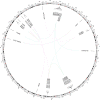Integrated methylome and phenome study of the circulating proteome reveals markers pertinent to brain health
- PMID: 35945220
- PMCID: PMC9363452
- DOI: 10.1038/s41467-022-32319-8
Integrated methylome and phenome study of the circulating proteome reveals markers pertinent to brain health
Abstract
Characterising associations between the methylome, proteome and phenome may provide insight into biological pathways governing brain health. Here, we report an integrated DNA methylation and phenotypic study of the circulating proteome in relation to brain health. Methylome-wide association studies of 4058 plasma proteins are performed (N = 774), identifying 2928 CpG-protein associations after adjustment for multiple testing. These are independent of known genetic protein quantitative trait loci (pQTLs) and common lifestyle effects. Phenome-wide association studies of each protein are then performed in relation to 15 neurological traits (N = 1,065), identifying 405 associations between the levels of 191 proteins and cognitive scores, brain imaging measures or APOE e4 status. We uncover 35 previously unreported DNA methylation signatures for 17 protein markers of brain health. The epigenetic and proteomic markers we identify are pertinent to understanding and stratifying brain health.
© 2022. The Author(s).
Conflict of interest statement
R.E.M. has received a speaker fee from Illumina and is an advisor to the Epigenetic Clock Development Foundation. A.M.M. has previously received speaker’s fees from Illumina and Janssen and research grant funding from The Sackler Trust. R.F.H. has received consultant fees from Illumina. All other authors declare no competing interest.
Figures






Similar articles
-
Epigenetic scores for the circulating proteome as tools for disease prediction.Elife. 2022 Jan 13;11:e71802. doi: 10.7554/eLife.71802. Elife. 2022. PMID: 35023833 Free PMC article.
-
An integrated genetic-epigenetic analysis of schizophrenia: evidence for co-localization of genetic associations and differential DNA methylation.Genome Biol. 2016 Aug 30;17(1):176. doi: 10.1186/s13059-016-1041-x. Genome Biol. 2016. PMID: 27572077 Free PMC article.
-
Epigenome-wide association study of incident type 2 diabetes: a meta-analysis of five prospective European cohorts.Diabetologia. 2022 May;65(5):763-776. doi: 10.1007/s00125-022-05652-2. Epub 2022 Feb 15. Diabetologia. 2022. PMID: 35169870 Free PMC article.
-
A concise review of human brain methylome during aging and neurodegenerative diseases.BMB Rep. 2019 Oct;52(10):577-588. doi: 10.5483/BMBRep.2019.52.10.215. BMB Rep. 2019. PMID: 31462381 Free PMC article. Review.
-
Genetic-epigenetic interactions in cis: a major focus in the post-GWAS era.Genome Biol. 2017 Jun 19;18(1):120. doi: 10.1186/s13059-017-1250-y. Genome Biol. 2017. PMID: 28629478 Free PMC article. Review.
Cited by
-
Proteomic signatures of corona and herpes viral antibodies identify IGDCC4 as a mediator of neurodegeneration.Sci Adv. 2025 May 30;11(22):eadt7176. doi: 10.1126/sciadv.adt7176. Epub 2025 May 30. Sci Adv. 2025. PMID: 40446030 Free PMC article.
-
Epigenetic profiles integrated with transcriptomic reveal the difference between COPD and PRISm in KOCOSS-NIH.Funct Integr Genomics. 2025 Apr 10;25(1):86. doi: 10.1007/s10142-025-01593-2. Funct Integr Genomics. 2025. PMID: 40205238 Free PMC article.
-
The circulating proteome and brain health: Mendelian randomisation and cross-sectional analyses.Transl Psychiatry. 2024 May 18;14(1):204. doi: 10.1038/s41398-024-02915-x. Transl Psychiatry. 2024. PMID: 38762535 Free PMC article.
-
Newborn mitochondrial DNA copy number is associated with changes to DNA methylation that persist into childhood and are associated with cognitive development.Clin Epigenetics. 2025 Jul 2;17(1):112. doi: 10.1186/s13148-025-01896-y. Clin Epigenetics. 2025. PMID: 40605063 Free PMC article.
-
Epigenome-wide association study of global cortical volumes in generation Scotland: Scottish family health study.Epigenetics. 2022 Oct;17(10):1143-1158. doi: 10.1080/15592294.2021.1997404. Epub 2021 Nov 23. Epigenetics. 2022. PMID: 34738878 Free PMC article.
References
-
- Biondo F, et al. Brain-age predicts subsequent dementia in memory clinic patients. Alzheimer’s Dement. 2020;16:e037378. doi: 10.1002/alz.037378. - DOI
Publication types
MeSH terms
Substances
Grants and funding
- 108890/Z/15/Z/WT_/Wellcome Trust/United Kingdom
- MC_PC_17209/MRC_/Medical Research Council/United Kingdom
- MC_PC_17215/MRC_/Medical Research Council/United Kingdom
- CZD/16/6/CSO_/Chief Scientist Office/United Kingdom
- G1001245/MRC_/Medical Research Council/United Kingdom
- MR/W002566/1/MRC_/Medical Research Council/United Kingdom
- CS/15/5//BHF_/British Heart Foundation/United Kingdom
- 225442/Z/22/Z/WT_/Wellcome Trust/United Kingdom
- MC_UU_00007/10/MRC_/Medical Research Council/United Kingdom
- WT_/Wellcome Trust/United Kingdom
- MR/L023784/2/MRC_/Medical Research Council/United Kingdom
- 104036/Z/14/Z/WT_/Wellcome Trust/United Kingdom
- 220857/Z/20/Z/WT_/Wellcome Trust/United Kingdom
- MR/S010351/1/MRC_/Medical Research Council/United Kingdom
- 221890/Z/20/Z/WT_/Wellcome Trust/United Kingdom
- MR/W002388/1/MRC_/Medical Research Council/United Kingdom
- DH_/Department of Health/United Kingdom
- R01 AG054628/AG/NIA NIH HHS/United States
- MR/R024065/1/MRC_/Medical Research Council/United Kingdom
- R01 MH124873/MH/NIMH NIH HHS/United States
- G0701120/MRC_/Medical Research Council/United Kingdom
- BB/W008793/1/BB_/Biotechnology and Biological Sciences Research Council/United Kingdom
LinkOut - more resources
Full Text Sources
Miscellaneous

